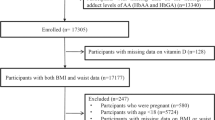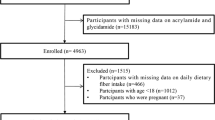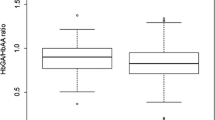Abstract
Osteoarthritis (OA) is the most prevalent degenerative joint disease, and acrylamide is a chemical produced when foods are processed at high temperatures. Recent epidemiological research linked acrylamide exposure from the diet and environment to a number of medical disorders. However, whether acrylamide exposure is associated with OA is still uncertain. This study was aimed at assessing the relationship between OA and hemoglobin adducts of acrylamide and its metabolite glycidamide (HbAA and HbGA). Data were taken from four cycles of the US NHANES database (2003–2004, 2005–2006, 2013–2014, 2015–2016). Individuals aged between 40 and 84 years who had complete information on arthritic status as well as HbAA and HbGA levels were eligible for inclusion. Univariate and multivariate logistic regression analysis s was performed to determine associations between study variables and OA. Restricted cubic splines (RCS) were used to examine non-linear associations between the acrylamide hemoglobin biomarkers and prevalent OA. A total of 5314 individuals were included and 954 (18%) had OA. After adjusting for relevant confounders, the highest quartiles (vs. lowest) of HbAA (adjusted odds ratio (aOR) = 0.87, 95% confidence interval (CI), 0.63–1.21), HbGA (aOR = 0.82, 95% CI, 0.60–1.12), HbAA + HbGA (aOR = 0.86, 95% CI, 0.63–1.19), and HbGA/HbAA (aOR = 0.88, 95% CI, 0.63–-1.25) were not significantly associated with greater odds for OA. RCS analysis revealed that HbAA, HbGA, and HbAA + HbGA levels were non-linearly and inversely associated with OA (p for non-linearity < 0.001). However, the HbGA/HbAA ratio displayed a U-shaped relationship with prevalent OA. In conclusion, acrylamide hemoglobin biomarkers are non-linearly associated with prevalent OA in a general US population. These findings implicate ongoing public health concerns for widespread exposure to acrylamide. Further studies are still warranted to address the causality and biologic mechanisms underlying the association.


Similar content being viewed by others
Data availability
All data analyzed during this study are included in this published article.
References
Ball HC, Alejo AL, Samson TK, Alejo AM, Safadi FF (2022) Epigenetic regulation of chondrocytes and subchondral bone in osteoarthritis. Life (basel) 12(4):582
Bassett JH, Williams GR (2016) Role of thyroid hormones in skeletal development and bone maintenance. Endocr Rev 37:135–187
Berenbaum F, Wallace IJ, Lieberman DE, Felson DT (2018) Modern-day environmental factors in the pathogenesis of osteoarthritis. Nat Rev Rheumatol 14(11):674–681
Chadha R (2016) Revealed aspect of metabolic osteoarthritis. J Orthop 13(4):347–351
Cheang I, Liao S, Zhu X, Lu X, Zhu Q, Yao W, Zhou Y, Zhang H, Li X (2021) Association of acrylamide hemoglobin biomarkers with serum lipid levels in general US population: NHANES 2013–2016. Ecotoxicol Environ Saf 214:112111
Chu PL, Lin LY, Chen PC, Su TC, Lin CY (2017) Negative association between acrylamide exposure and body composition in adults: NHANES, 2003–2004. Nutr Diabetes 7:e246
Chu PL, Liu HS, Wang C, Lin CY (2020) Association between acrylamide exposure and sex hormones in males: NHANES, 2003–2004. PLoS One 15:e0234622
Deprouw C, Courties A, Fini JB, Clerget-Froidevaux MS, Demeneix B, Berenbaum F, Sellam J, Louati K (2022) Pollutants: a candidate as a new risk factor for osteoarthritis-results from a systematic literature review. RMD Open 8(2):e001983
Desquilbet L, Mariotti F (2010) Dose-response analyses using restricted cubic spline functions in public health research. Stat Med 29(9):1037–1057
Ebell MH (2018) Osteoarthritis: rapid evidence review. Am Fam Physician 97:523–526
Guo J, Yu D, Lv N, Bai R, Xu C, Chen G, Cao W (2017) Relationships between acrylamide and glycidamide hemoglobin adduct levels and allergy-related outcomes in general US population, NHANES 2005–2006. Environ Pollut 225:506–513
Hogervorst JG, Baars BJ, Schouten LJ, Konings EJ, Goldbohm RA, van den Brandt PA (2010) The carcinogenicity of dietary acrylamide intake: a comparative discussion of epidemiological and experimental animal research. Crit Rev Toxicol 40:485–512
Huang YF, Chiang SY, Liou SH, Chen ML, Chen MF, Uang SN, Wu KY (2012) The modifying effect of CYP2E1, GST, and mEH genotypes on the formation of hemoglobin adducts of acrylamide and glycidamide in workers exposed to acrylamide. Toxicol Lett 215(2):92–99
Huang M, Zhuang P, Jiao J, Wang J, Zhang Y (2018) Association of acrylamide hemoglobin biomarkers with obesity, abdominal obesity and overweight in general US population: NHANES 2003–2006. Sci Total Environ 631–632:589–596
Hung CC, Cheng YW, Chen WL, Fang WH (2021) Negative association between acrylamide exposure and metabolic syndrome markers in adult population. Int J Environ Res Public Health 18(22):11949
Katz JN, Arant KR, Loeser RF (2021) Diagnosis and Treatment of Hip and Knee Osteoarthritis: A Review. JAMA 325(6):568–578
Koszucka A, Nowak A, Nowak I, Motyl I (2020) Acrylamide in human diet, its metabolism, toxicity, inactivation and the associated European Union legal regulations in food industry. Crit Rev Food Sci Nutr 60:1677–1692
Li M, Sun J, Zou F, Bai S, Jiang X, Jiao R, Ou S, Zhang H, Su Z, Huang Y, Bai W (2017) Glycidamide inhibits progesterone production through reactive oxygen species-induced apoptosis in R2C Rat Leydig Cells. Food Chem Toxicol 108(Pt B):563–570
Marchev AS, Dimitrova PA, Burns AJ, Kostov RV, Dinkova-Kostova AT, Georgiev MI (2017) Oxidative stress and chronic inflammation in osteoarthritis: can NRF2 counteract these partners in crime? Ann N Y Acad Sci 1401:114–135
Matoso V, Bargi-Souza P, Ivanski F, Romano MA, Romano RM (2019) Acrylamide: a review about its toxic effects in the light of Developmental Origin of Health and Disease (DOHaD) concept. Food Chem 283:422–430
National Center for Health Statistics (n.d). Updated August 24, 2022b. Accessed September 8, 2022. https://www.cdc.gov/nchs/nhanes/irba98.htm
National Center for Health Statistics (n.d). Updated August 24, 2022a. Accessed September 8, 2022. https://www.cdc.gov/nchs/nhanes/index.htm
Oliveira VM, Ivanski F, Oliveira IM, Bargi-Souza P, Schiessel DL, Romano MA, Romano RM (2020) Acrylamide induces a thyroid allostasis-adaptive response in prepubertal exposed rats. Curr Res Toxicol 1:124–132
Palazzo C, Nguyen C, Lefevre-Colau MM, Rannou F, Poiraudeau S (2016) Risk factors and burden of osteoarthritis. Ann Phys Rehabil Med 59:134–138
Pan X, Wu X, Yan D, Peng C, Rao C, Yan H (2018) Acrylamide-induced oxidative stress and inflammatory response are alleviated by N-acetylcysteine in PC12 cells: Involvement of the crosstalk between Nrf2 and NF-κB pathways regulated by MAPKs. Toxicol Lett 288:55–64
Pedersen M, Vryonidis E, Joensen A, Törnqvist M (2022) Hemoglobin adducts of acrylamide in human blood - what has been done and what is next? Food Chem Toxicol 161:112799
Peeters GM, Alshurafa M, Schaap L, de Vet HC (2015) Diagnostic accuracy of self-reported arthritis in the general adult population is acceptable. J Clin Epidemiol 68(4):452–459
Pelucchi C, Bosetti C, Galeone C, La Vecchia C (2015) Dietary acrylamide and cancer risk: an updated meta-analysis. Int J Cancer 136:2912–2922
Rifai L, Saleh FA (2020) A review on acrylamide in food: occurrence, toxicity, and mitigation strategies. Int J Toxicol 39:93–102
Robinson WH, Lepus CM, Wang Q, Raghu H, Mao R, Lindstrom TM, Sokolove J (2016) Low-grade inflammation as a key mediator of the pathogenesis of osteoarthritis. Nat Rev Rheumatol 12:580–592
Sanchez-Lopez E, Coras R, Torres A, Lane NE, Guma M (2022) Synovial inflammation in osteoarthritis progression. Nat Rev Rheumatol 18:258–275
Sansano M, Heredia A, Peinado I, Andrés A (2017) Dietary acrylamide: what happens during digestion. Food Chem 237:58–64
Shimamura Y, Okuda A, Ichikawa K, Inagaki R, Ito S, Honda H, Masuda S (2021) Factors influencing the formation of chemical-hemoglobin adducts. Toxics 10(1):2
van den Bosch MHJ (2021) Osteoarthritis year in review 2020: biology. Osteoarthritis Cartilage 29:143–150
Vesper HW, Ospina M, Meyers T, Ingham L, Smith A, Gray JG, Myers GL (2006) Automated method for measuring globin adducts of acrylamide and glycidamide at optimized Edman reaction conditions. Rapid Commun Mass Spectrom 20:959–964
Woodell-May JE, Sommerfeld SD (2020) Role of inflammation and the immune system in the progression of osteoarthritis. J Orthop Res 38(2):253–257
Yan YS, Qu Z, Yu DQ, Wang W, Yan S, Huang HF (2021) Sex steroids and osteoarthritis: a Mendelian randomization study. Front Endocrinol (lausanne) 12:683226
Yin G, Liao S, Gong D, Qiu H (2021) Association of acrylamide and glycidamide haemoglobin adduct levels with diabetes mellitus in the general population. Environ Pollut 277:116816
Zhang Y, Huang M, Zhuang P, Jiao J, Chen X, Wang J, Wu Y (2018) Exposure to acrylamide and the risk of cardiovascular diseases in the National Health and Nutrition Examination Survey 2003–2006. Environ Int 117:154–163
Zipf G, Chiappa M, Porter KS, Ostchega Y, Lewis BG, Dostal J (2013) National health and nutrition examination survey: plan and operations, 1999–2010. Vital Health Stat 1:1–37
Acknowledgements
The authors acknowledge the efforts of the US National Center for Health Statistics (NCHS) in the creation of the National Health and Nutrition Examination Survey data. The interpretation and reporting of these data are the sole responsibility of the authors.
Author information
Authors and Affiliations
Contributions
Feng-chao Zhao: conception and design, analysis and interpretation of data, drafting of the manuscript, data acquisition, and critical revision of the manuscript.
Xiang Li: conception and design, analysis and interpretation of data, drafting of the manuscript, and critical revision of the manuscript.
Yu-xin Wang: conception and design, analysis and interpretation of data, drafting of the manuscript, data acquisition, and critical revision of the manuscript.
Sheng-jie Zhou and Yang Lu: drafting of the manuscript and data acquisition.
All authors read and approved the final manuscript.
Corresponding author
Ethics declarations
Ethics approval and consent to participate
The NCHS Research Ethics Review Board reviews and approves the NHANES, and all survey participants provided written informed consent for participation and examinations and laboratory studies. All NHANES data released by the NCHS are de-identified, and the data remain anonymous during data analysis. No further ethical approval or informed consent was required to perform the data analysis of this study. The approval is available on the NHANES website (https://www.cdc.gov/nchs/nhanes/irba98.htm).
Consent for publication
Not applicable.
Competing interests
The authors declare no competing interests.
Additional information
Responsible Editor: Lotfi Aleya
Publisher's note
Springer Nature remains neutral with regard to jurisdictional claims in published maps and institutional affiliations.
Highlights
• To date, the connection between acrylamide exposure and osteoarthritis (OA) is uncertain.
• Data from the US NHANES were queried to explore the association between acrylamide hemoglobin adducts and OA.
• HbAA, HbGA, and HbAA + HbGA levels are non-linearly and inversely associated with OA, while HbGA/HbAA ratio displayed a U-shaped relationship with prevalent OA.
• These findings implicate ongoing public health concerns associated with environmental and dietary exposure to acrylamide.
Rights and permissions
Springer Nature or its licensor (e.g. a society or other partner) holds exclusive rights to this article under a publishing agreement with the author(s) or other rightsholder(s); author self-archiving of the accepted manuscript version of this article is solely governed by the terms of such publishing agreement and applicable law.
About this article
Cite this article
Zhao, Fc., Li, X., Wang, Yx. et al. Relationship between acrylamide and glycidamide hemoglobin adduct levels and osteoarthritis: a NHANES analysis. Environ Sci Pollut Res 30, 75262–75272 (2023). https://doi.org/10.1007/s11356-023-27515-y
Received:
Accepted:
Published:
Issue Date:
DOI: https://doi.org/10.1007/s11356-023-27515-y




